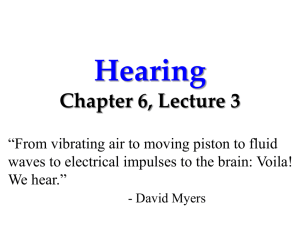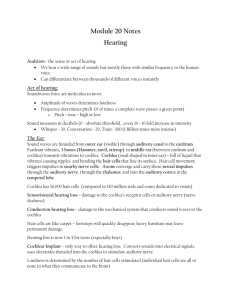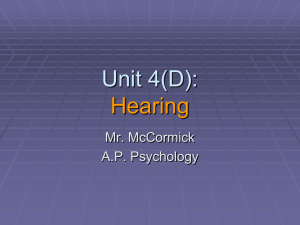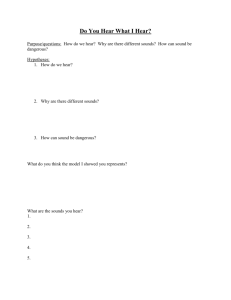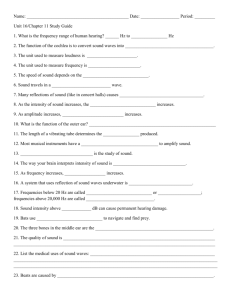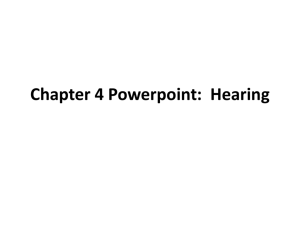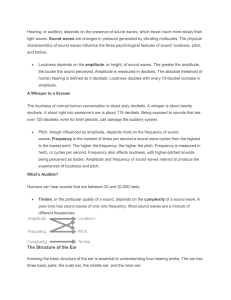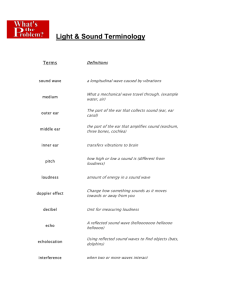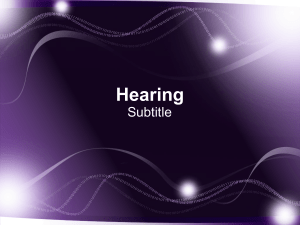AP Psychology ~ Ms. Justice
advertisement
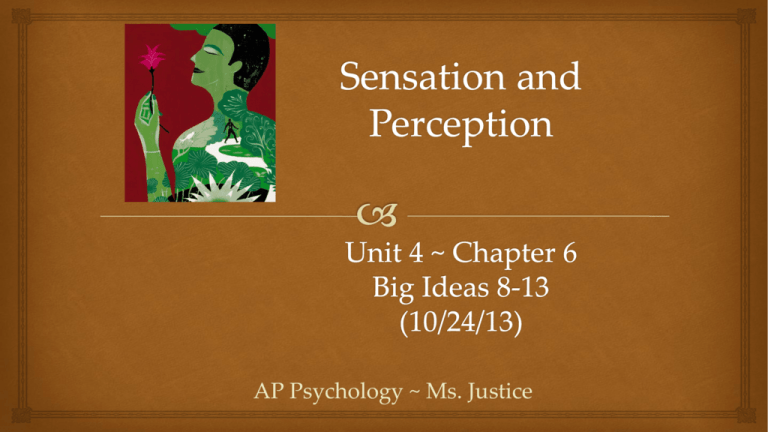
AP Psychology ~ Ms. Justice 8: What are the characteristics of air pressure waves that we hear as sound? Audition Audition, or hearing, is highly adaptive. We hear a wide range of sounds, but we hear best those sounds with frequencies in a range corresponding to that of the human voice. We are also remarkably attuned to variations in sounds: For example, we easily detect differences among thousands of human voices. Sound Characteristics Sound waves are compressing and expanding air molecules. The wave’s frequency, or length, determine the pitch we experience. Long waves have a low frequency & pitch. Short waves have a high frequency & pitch. The wave’s intensity, or strength, determines the loudness we experience. 9: How does the ear transform sound energy into neural messages? The Ear Sound waves are converted into neural activity: Outer Ear: Collects and sends sounds to the eardrum. Middle Ear: Chamber between eardrum and cochlea containing three tiny bones (hammer, anvil, stirrup) that concentrate the vibrations of the eardrum on the cochlea’s oval window. Inner Ear: Innermost part of the ear, containing the cochlea, semicircular canals, and vestibular sacs. Cochlea Cochlea: Coiled, bony, fluid-filled tube in the inner ear that transforms sound vibrations to auditory signals. Intensity (Loudness) Intensity (Loudness): Amount of energy in a wave, determined by the amplitude, relates to the perceived loudness. Loudness of Sound Richard Kaylin/ Stone/ Getty Images 120dB 70dB 120dB Page 248 10: What theories help us understand pitch perception? Frequency (Pitch) Pitch: The dimension of frequency determined by the wavelength of sound. Frequency theory: The rate of nerve impulses traveling up the auditory nerve matches the frequency of a tone; enabling us to sense its pitch. Best explains how we sense low pitches. Place theory: links the pitch we hear with the place where the cochlea's membrane is stimulated. Best explains how we sense high pitches. A combination of the two theories handle the pitches in the intermediate range. 11: How do we locate sounds? Localization of Sounds Because we have two ears, sounds that reach one ear faster than the other ear causes us to localize the sound. Your right ear would receive a more intense sound from this bell ringing, and it would receive the sound slightly sooner than your left ear. However, the intensity difference and time lag are extremely small. 12: What are the common causes of hearing loss, and why does controversy surround cochlear implants? Hearing loss & deaf culture Conduction hearing loss: problems with the mechanical system that conducts sound waves to the cochlea Sensorineural hearing loss: damage to the cochlea’s hair cell receptors or their associated nerves (more common) Cochlear implants: electronic devices that translate sounds into electric signals that convey some information about sound to the brain. 13: How do we sense touch and our body’s position and movement? How do we experience pain? TOUCH Bruce Ayers/ Stone/ Getty Images The sense of touch is a mix of four distinct skin senses—pressure, warmth, cold, and pain. Body Position &Movement The sense of our body parts’ position and movement is called kinesthesis. The vestibular sense monitors the head (and body’s) position (including balance). Bob Daemmrich/ The Image Works http://www.heyokamagazine.com Pain Pain tells the body that something has gone wrong. Usually pain results from damage to the skin and other tissues. A rare disease exists in which the afflicted person feels no pain: Ashlyn Blocker Gate-Control Theory Melzack and Wall (1965, 1983) proposed that our spinal cord contains neurological “gates” that either block pain or allow it to be sensed. Gary Comer/ PhototakeUSA.com The “gate” is opened by the activity of pain signals traveling up small nerve fibers, and is closed by activity in large nerve fibers or by information coming from the brain. Biopsychosocial Influences Figure 6.22: p. 257 Pain Control Pain can be controlled by a number of therapies including, drugs, surgery, acupuncture, exercise, hypnosis, and even thought distraction. Todd Richards and Aric Vills, U.W. ©Hunter Hoffman, www.vrpain.com
